This article was co-authored by Laura Marusinec, MD. Dr. Marusinec is a board certified Pediatrician at the Children's Hospital of Wisconsin, where she is on the Clinical Practice Council. She received her M.D. from the Medical College of Wisconsin School of Medicine in 1995 and completed her residency at the Medical College of Wisconsin in Pediatrics in 1998. She is a member of the American Medical Writers Association and the Society for Pediatric Urgent Care.
This article has been viewed 189,225 times.
Anyone who spends time around children knows that vomiting is unfortunately not an unusual activity for them. Vomiting in children is usually caused by a virus, over-exertion/excitement, or motion sickness, and is not normally a reason for significant medical concern. It can be, however, worrisome to the child and a messy problem for you. By recognizing the common causes and acting proactively against nausea and other triggers, you stand a much better chance of preventing vomiting in children.
Steps
Recognizing Causes
-
1Assume it is a stomach bug. Because they often interact in close quarters and don’t always practice the best hygiene, children easily spread viruses. Vomiting can be a common symptom, along with fever, weakness, tiredness, and diarrhea, among others.[1]
- Teaching your child good hygiene (like frequent hand-washing) and steering clear of other sick children are the best way to reduce the likelihood of getting sick from a stomach virus, but don’t expect miracles when dealing with kids.
- Vomiting due to a stomach virus usually clears up within 12–24 hours. If vomiting continues for more than a day or two, gets worse (for instance, the child cannot keep down liquids), or other symptoms worsen, contact your child’s doctor or seek medical attention.
- Rest and rehydration are the best treatments for this type of vomiting. Have the child rest in a reclined position with her head turned to the side (to prevent aspiration of vomit), and offer regular, small doses of electrolyte solutions, sugar water, Popsicles, gelatin water, or other liquids as recommended by the pediatrician. If she continues to vomit every time you try small amounts of fluids, stop and call your doctor right away.
-
2Consider the possibility of other common causes. Absent other evidence, a stomach virus should be your first guess for the cause of vomiting. However, other illnesses and even simple childhood activities can bring it on.[2]
- If your child has a respiratory infection, such as a common cold, sometimes this can lead to vomiting because of continuous coughing and the drainage of mucus into the stomach. An ear infection can also sometimes cause vomiting.
- Sometimes throwing up can be triggered by a long bout of crying. If your child is very upset and cries continuously for a long period of time, he can make himself sick and begin throwing up.
- Overeating can cause vomiting, as can overexertion. Mixing the two is often a recipe for disaster.
- Food allergies or intolerances can cause vomiting. Take note if certain foods seem to trigger vomiting and inform the pediatrician. Seek immediate medical attention if the vomiting is associated with hives. swelling of the face or body, or trouble breathing.
- Anxiety and excessive stress can also lead to vomiting, not to mention headaches and other maladies. Sources of anxiety in children can range from school troubles to family breakups to fear of monsters in the dark. Stress reduction strategies, behavioral therapy, and perhaps even medication may help reduce both anxiety and the resulting episodes of vomiting.[3]
Advertisement -
3Be aware of unusual but serious causes. Vomiting in children is usually not something you need to be overly worried about, but it is prudent to be aware of potentially serious causes. Call your child’s doctor or seek medical attention if:[4]
- Your child is vomiting and has a severe headache or neck stiffness.
- The vomiting is forceful or projectile, especially in a baby.
- Your child vomits due to head trauma or injury, as she may have a concussion or more serious injury.
- There is blood (possibly appearing like coffee grounds) or bile (usually green in color) in your child’s vomit, as these can indicate serious stomach or intestinal conditions.
- Your child is noticeably lethargic or has a marked change in mental status, which can indicate severe dehydration
- Your child has severe abdominal pain, which can be caused by meningitis or appendicitis.
- There is the possibility that your child has consumed a toxin or poison.
-
4Understand motion sickness.[5] This may be the most frustrating common cause of vomiting in children, as it can make the car trip to Grandma’s house a recurring disaster. Knowing your enemy is the first step towards conquering it.
- Motion sickness occurs when the “motion sensors” in your body — eyes, inner ears, and nerves in the extremities — receive conflicting information.
- Thus, when your body is moving but your eyes are looking at a stationary book or video screen, you may experience motion sickness.
- It is not clear why children tend to experience vomiting with motion sickness more often, but children ages two to 12 seem most susceptible.
Dealing With Nausea and Other Triggers
-
1Combat nausea by keeping your child hydrated. While it is an essential treatment after vomiting, small but frequent sips of liquids can help calm nausea before vomiting as well.[6]
- Have your child drink small amounts of clear liquids. Because drinks that contain sugar can help soothe an upset stomach, offer sweetened liquids such as flat soda or fruit juices. Popsicles also work well. The sugar in these drinks can help to calm the stomach better than water alone.
- Electrolyte solutions such as Pedialyte can be helpful if your child will drink them.
- Let sodas like cola or ginger ale go flat before giving it to ease nausea, as the carbonation can further upset the stomach.[7]
- Stay away from juices that are too acidic like grapefruit and orange juice, as these juices can make the stomach feel worse.
- Pediatricians generally prefer focusing on hydration with nausea (or after vomiting) over the use of anti-emetic (anti-vomiting) medications because of the risk of side effects with the latter. However, if nausea or vomiting are severe or continuing, anti-nausea and vomiting medications may be recommended and can be very effective.
-
2Encourage your child to rest when feeling ill and relax while eating. It can be a tall task to get an active child to calm down, even when he is feeling ill, but appropriate rest and relaxation are some of the best tools to prevent vomiting.[8]
- Resting can help to calm your stomach. Sitting or lying in a propped up position is preferable.
- Any physical activity can make nausea worse. Encourage your child to stop playing until the nausea passes.
- Try not to let your child eat while he is playing. Encourage your child to sit down and have his snack. If he runs around while eating, this motion can lead to sickness. (It is also a choking hazard.)
- If you suspect overeating may be contributing to vomiting episodes, try offering smaller, more frequent meals. Replace fatty, heavy foods with more fruits and vegetables.
-
3Control a persistent cough. If your child’s vomiting is caused by a persistent cough, getting rid of the cough should also get rid of the risk of vomiting.[9] See your doctor if the cough is severe or not improving after one week to see if medical treatment may be needed.
- Always follow dosing recommendations for over-the-counter cough medications. Check with the pediatrician before giving any medicine to small children, especially medicines not intended for that age group. Most pediatricians don't recommend cough medicines for children, especially under age eight. If your child is older than one, talk to your doctor about giving honey for coughs.
- If your child is old enough to safely suck on lozenges or hard candy, these may also help soothe a cough. Err on the side of caution with young children, especially if they are under four, to prevent choking.
-
4Prepare for car sickness ahead of time. A little planning beforehand, and some quick action if motion sickness symptoms appear, can prevent major delays (and clean-up operations) later.[10]
- Schedule plenty of stops during your trips. This will help give your child a chance to get some fresh air and will calm her stomach. If car sickness develops, stop immediately and allow the child to get out of the car and either walk around or lie on her back with her eyes closed.
- It can help if your child has something in her stomach, especially for a longer trip. Try giving her a small snack before the car ride. Be sure to give her something that is not too sweet or fatty, though. Crackers, bananas, and applesauce make a good snack to help prevent nausea.
- Be sure to give your child plenty of fluids before and during a car ride. This will also help calm her stomach by keeping her hydrated.
- Seat your child so that she faces the front windshield when riding in the car. Watching movement out of the side windows can worsen nausea. But always follow proper car seat usage, even if this means your child must face backwards.
- Distract your child from any feelings of car sickness by listening to or singing songs, or just talking. Books and video screens can exacerbate motion sickness.
- There are also several medications for motion sickness. However, before giving your child any over-the-counter medicine, it is advisable to consult your doctor. Motion sickness medications can also cause side effects like drowsiness that may last long after the car trip ends.
Warnings
- Contact your doctor right away if your newborn or young infant is vomiting.⧼thumbs_response⧽
- It is important to consult a doctor if your child’s vomiting persists for more than 24 hours and they cannot keep down any liquids or any foods for this period of time. In addition, call your doctor if your child has signs of dehydration, such as dry mouth, no tears when crying, decreased activity, or no urine for 6-8 hours.⧼thumbs_response⧽
- Before giving your child any over the counter medications for motion sickness or for a persistent cough, it is important to check with her doctor to make sure the medicine is safe for your child.⧼thumbs_response⧽
References
- ↑ https://www.healthychildren.org/English/health-issues/conditions/abdominal/Pages/Treating-Vomiting.aspx
- ↑ http://my.clevelandclinic.org/health/diseases_conditions/hic_Nausea_and_Vomiting
- ↑ http://www.merckmanuals.com/home/children-s-health-issues/mental-health-disorders-in-children-and-adolescents/overview-of-anxiety-disorders-in-children
- ↑ http://www.parents.com/health/stomach-ache/vomiting/
- ↑ https://www.healthychildren.org/English/health-issues/conditions/head-neck-nervous-system/Pages/Car-Sickness.aspx
- ↑ http://my.clevelandclinic.org/health/diseases_conditions/hic_Nausea_and_Vomiting
- ↑ https://www.nlm.nih.gov/medlineplus/ency/patientinstructions/000122.htm
- ↑ http://my.clevelandclinic.org/health/diseases_conditions/hic_Nausea_and_Vomiting
- ↑ http://my.clevelandclinic.org/health/diseases_conditions/hic_Nausea_and_Vomiting
About This Article
If your child is vomiting and also experiencing a severe headache, neck stiffness, severe stomach pain, blood in their vomit, or a change in their mental state, you should contact a doctor immediately since these symptoms might indicate a potentially serious condition. Otherwise, the cause is most likely a common stomach bug or car sickness. To combat nausea, give your child small but frequent sips of clear liquids with sugar, like juice or flat soda. Additionally, encourage your child to rest and avoid physical activity. If you think overeating might be causing the vomiting, try offering smaller, more frequent meals and replace fatty, heavy foods with more fruits and vegetables. For more tips from our Medical co-author, like how to prevent car sickness, keep reading!
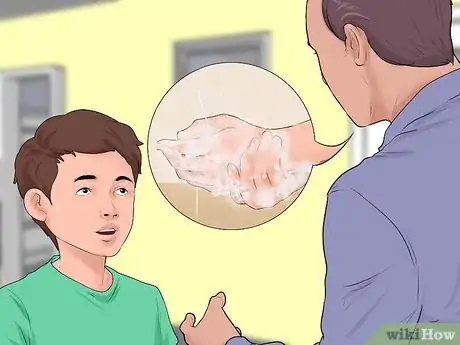
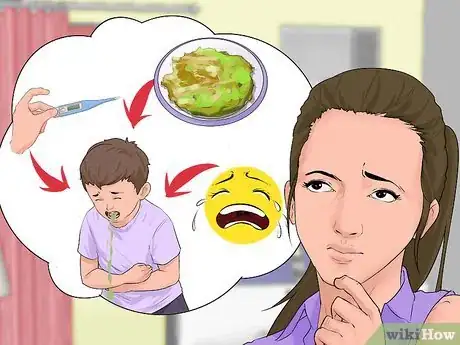
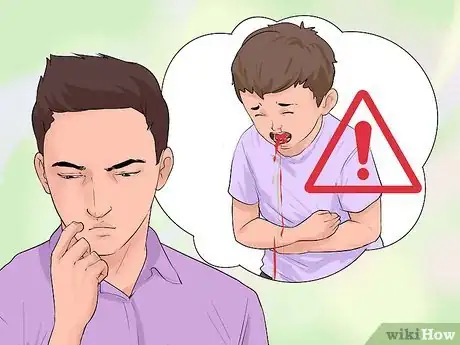
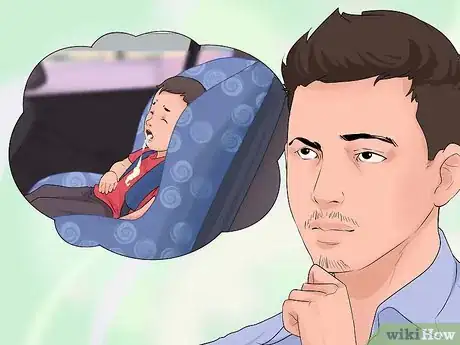

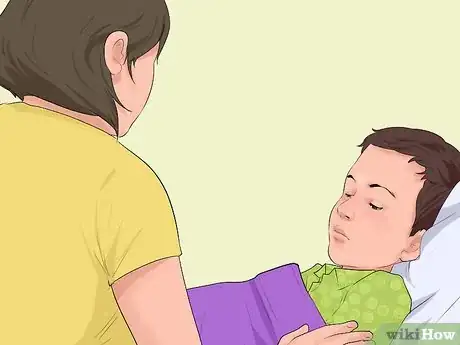

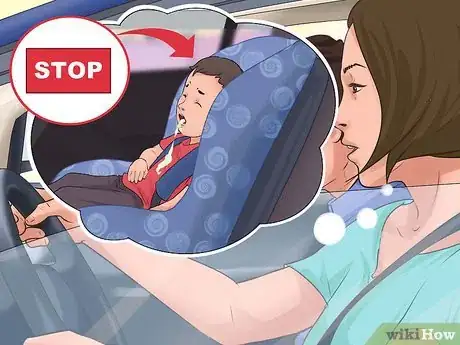


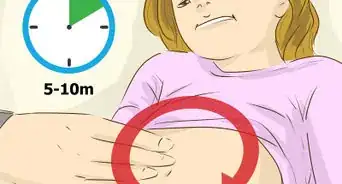





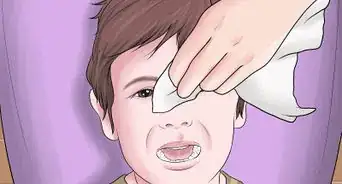

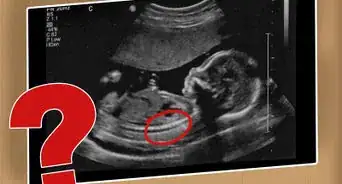














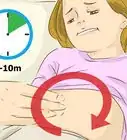





































Medical Disclaimer
The content of this article is not intended to be a substitute for professional medical advice, examination, diagnosis, or treatment. You should always contact your doctor or other qualified healthcare professional before starting, changing, or stopping any kind of health treatment.
Read More...